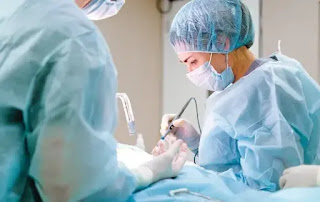How does Laparoscopy Treatment help with IVF?
A laparoscopy is a surgical procedure that allows a fertility doctor to see inside the abdomen. In women, the uterus, fallopian tubes, and ovaries are in the pelvis, at the very bottom of the abdomen. Laparoscopy allows fertility doctors to see abnormalities that may affect a woman’s ability to conceive. The most common problems are endometriosis, pelvic adhesions, ovarian cysts, and fibroids.
What is a laparoscope?
A Laparoscope is a thin fiber-optic telescope that is inserted into the abdomen, usually through the navel. Fiber optics allow you to see inside the abdomen using light. Carbon dioxide (CO2) gas is sent into the abdomen before the laparoscope is inserted.
This lifts the abdominal wall and allows some separation of the abdominal organs, making it easier for the fertility doctor to see the genitals during surgery. If abnormalities are found during the laparoscopy, additional instruments can be inserted into the abdomen through a small incision.
The incision is usually made on the left and/or right side of the pubic hairline. Together with the abdominal button laparoscope, it forms a triangle, allowing fertility doctors to perform virtually any surgical procedure that can be performed with a traditional “open” surgery involving a larger incision. Laparoscopy is performed under general anesthesia. This means the patient is completely asleep throughout the procedure.
What are the advantages of laparoscopy in infertility?
Laparoscopy can diagnose infertility problems that otherwise go unnoticed. For example, women with severe endometriosis can be identified using ultrasound. Women with mild endometriosis can only be identified through surgery, such as laparoscopy.
Another problem that can only be detected by surgery is adhesions in the pelvic area. Adhesions, also called scar tissue, cannot be seen on ultrasound, x-rays, or CT scans. If adhesions make it difficult for the egg to enter the fallopian tube during ovulation, conception can be prevented.
Many people consider laparoscopy to be a less invasive procedure than traditional surgery. Conventional surgery requires an incision several centimeters long in the abdomen. This means that the patient has to stay 2-3 nights in the hospital. Laparoscopy uses 1 to 3 small incisions. Each incision can be 0.5 cm to 1 cm long. In most cases, patients who have a laparoscopy can go home on the same day as the surgery. This usually means that hospitalization is not required. Some believe that laparoscopy reduces adhesions after reproductive surgery. But that doesn’t seem to be the case.
What are the disadvantages of laparoscopy in infertility?
Laparoscopy requires unique skills than traditional surgery. It can often be more difficult to complete the procedure. For example, the removal of superficial medium-sized uterine fibroids can be accomplished equally well by laparoscopy or conventional surgery. But women with dozens of fibroids, large and small, some occupying the deep layers of the uterus, do much better with conventional surgery
I know when and when it will be detrimental.
Which infertile patients should undergo laparoscopy?
If possible, it should be limited to couples who have already completed more basic infertility tests, such as a semen analysis. Some couples may choose to skip a laparoscopy to continue with other fertility treatments such as B. Superovulation by fertility drugs combined with intrauterine insemination or in vitro fertilization. You may suspect that your fertility doctor has found a problem with your laparoscopy.
For example, women who have a history of serious pelvic infections or a ruptured appendix are more likely to develop pelvic adhesions and thus are more likely to benefit from laparoscopy
Laparoscopy vs IVF
Pelvic adhesions and endometriosis, two common problems she encounters during laparoscopy, can also be effectively treated with IVF. Because IVF is less invasive than laparoscopy and has a much higher success rate, some couples choose to skip laparoscopy and go straight to IVF. Even if a woman has severe untreated adhesions, there is no effect on her ability to conceive with IVF. It is of the same nature as surgery.
Any type of surgery can present problems with anesthesia, bleeding, and infection. Both types of surgery carry the risk of damaging internal organs.
Common Side Effects
Skin irritation at the incision site
- Cystitis due to retention of urine during surgery
- Adhesions
- Infection at the incision site.
- Abdominal hematoma
- Gases from carbon dioxide.
- Muscle pain and fatigue
- Mild nausea, pain, and abdominal discomfort
- Shoulder pain from carbon dioxide
What to expect after laparoscopy?
Her Incision will be covered with a dressing that can be removed after 24 hours
The fertility doctor prescribes postoperative pain and nausea. Most people need pain relievers and may or may not need anti-nausea drugs. Recovery time includes the type of intervention performed, the duration of surgery, the number of incisions made, whether the patient had previous surgery, the patient’s preoperative health, and whether there were any complications.
It is natural for patients to tolerate if and how. After a simple laparoscopy for infertility, the patient can eat and drink as much as they like. Because of the anesthesia, she will have to rest for 24 hours. As soon as she feels well enough, she can return to her normal activities afterward. Depending on the type of surgery, some women can return to work within a few days. For other women, it may take several weeks.
Summing it up
If you have trouble getting pregnant, try a laparoscopy. It's a safe and proven way to help you become a parent. Misdiagnosis leads to repeated treatments for non-existent diseases, leading to frustration and stress. Infertility causes such as endometriosis blocked fallopian tubes, and uterine scarring can only be detected by laparoscopy.
physicians employ methods of diagnosing and treating infertility. It provides a clear view of the reproductive organs and helps doctors detect abnormalities in the uterus, ovaries, and fallopian tubes. Although it is simple and non-invasive, there are risks such as bleeding and the destruction of internal organs. However, the benefits outweigh the risks.

